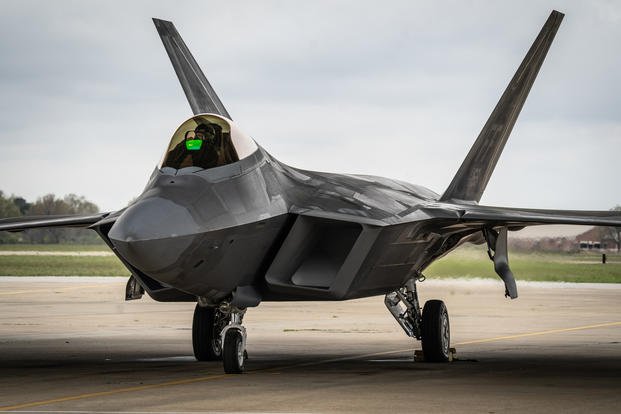For years, the U.S. Air Force has wanted to make simulated adversary air battles with its own fifth-generation aircraft routine, giving pilots much-needed experience to fend off advanced enemy fighters in the future.
Now, it may get that chance by using the F-22 Raptor in the role.
Read Next: US Soldier Charged with Planning Deadly Ambush on His Army Unit, DOJ Says
Gen. Mike Holmes, head of Air Combat Command, said Monday that the Air Force is considering moving some of its Formal Training Unit F-22s -- used for fundamental skills training -- into a combat-coded configuration, making more aircraft available for pilots to get operational experience earlier in their careers. And some of the older stealth Raptors could be used for "red air" training, he said.
It's part of Air Combat Command's new master plan to cut pilot training time by leveraging technologies -- such as augmented virtual reality simulators and aircraft the service already has -- in a more efficient way.
Holmes signed off on the strategy, known as "Rebuilding the Forge," or "Reforge," earlier this month, Air Force Magazine first reported. Under the plan, the Air Force aims to halve the time it takes to make a skilled fighter pilot to roughly 22 months, the magazine said.
"Part of what we're trying to do is see if we could create more capacity without spending more money," Holmes said during a Mitchell Institute event Monday. "This is primarily a 'think piece' for Air Combat Command, and it's based on, 'Can we make the Reforge initiative work?'"
The command is also studying ways it can use its older F-22s "smarter as we move the [Formal Training Unit] to Langley," he said of the Raptors at Joint Base Langley-Eustis, Virginia, the home of ACC. The schoolhouse was originally located at Tyndall Air Force Base, Florida, until the base suffered heavy damage from Hurricane Michael.
"One of the options that we're looking at is to fly those older airplanes in a red air role, and [instead] put our students in the FTU straight into the newest airplanes so they don't learn in the one [model] and then have to transition to the new one," Holmes said.
The plan would put pilots directly into the most modern, upgraded version of the aircraft during skills training; eliminate redundancy and a change-of-station move; and give them the know-how of combat experience up front, he said.
"With the two operational squadrons here [at Langley], and the red air requirements for them and the red air requirements for the FTU, [we're asking], 'Can we kind of trade airplanes among each other and make an effective use of the older airplanes in a red air role while we save our limited modernization dollars for … newer airplanes?'" Holmes said.
"We can take some of that training-coded iron and turn it into combat-coded iron. We already paid for it, we already pay for the people that fly it and operate it, so we could produce some increased capacity that way," he continued.
In 2018, the Government Accountability Office issued a study that found that the Air Force was not utilizing the F-22 to the fighter's full potential due to maintenance challenges and inadequate opportunities for pilot training.
The Defense Department in 2009 announced it would cap its F-22 inventory at 187, delivering the last aircraft in 2012. The service currently has 186 of the stealth fighters.
The Air Force, which last conducted an F-22 organizational review in 2010, chose to divide the fleet into smaller units, with "18 or 21 primary mission aircraft per squadron and one or two squadrons per wing," according to the report.
"Traditional fighter wings have three squadrons per wing with 24 aircraft in each squadron, which creates maintenance efficiencies because people, equipment and parts can be shared," the report added.
Holmes said Monday that the Air Force has since changed that structure to five squadrons of 24 aircraft -- not only to reduce maintenance inefficiencies, but because it allows the command to generate more sorties with a better balance of personnel and resources.
He said manned-unmanned teaming concepts, such as the Skyborg program's artificial intelligence network for drones like the XQ-58A Valkyrie, could also be used for adversary air training in the future.
The Air Force is still pursuing contracted options to fill aggressor air roles. Last year, the service formally kicked off its contract initiative by awarding seven companies a total of $6.4 billion to outsource its assault and combat training.
Regardless, pilots have wanted to go up against formidable opponents like the F-22 and the F-35 Joint Strike Fighter for a while.
While the Air Force still wants its "blue air" pilots to get good kills, "red air" pilots have not been getting the same experience if they remain easy targets, a fighter pilot told Military.com in 2017.
"The F-22 guys are hungry to get at a fifth-gen adversary like a [Chinese] J-20," the pilot said.
"The problem is, no squadron can replicate it unless you have dedicated fighter [squadrons of aircraft like the F-35 or F-22] acting as adversary air," he added. "And that'll never happen."
But the Air Force is working on ways to do it.
In addition to ACC's latest F-22 decision, the service last year announced that it was reactivating the 65th Aggressor Squadron, moving 11 of its older-generation F-35A Lightning IIs to Nellis Air Force Base, Nevada, to serve as aggressors.
"We need to be able to simulate a high-end adversary," then-Air Force Secretary Heather Wilson said of the arrangement. "And this is a pretty cost-effective way to do it."
-- Oriana Pawlyk can be reached at oriana.pawlyk@military.com. Follow her on Twitter at @Oriana0214.













